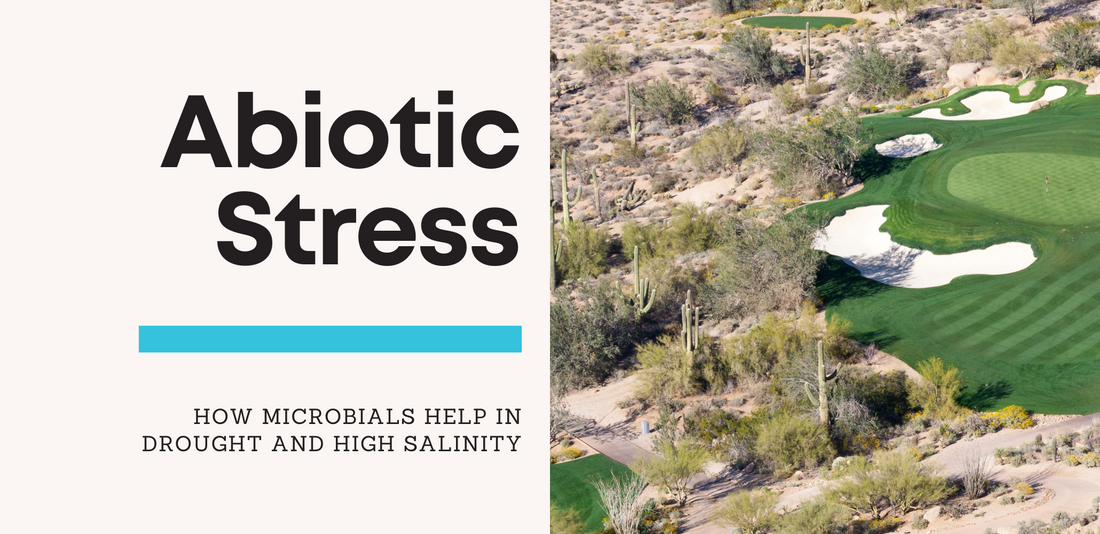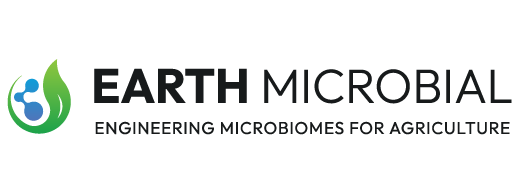
The Science: How Microbials Work to Mitigate Drought & Salinity Stress in Turfgrass
This blog is moved to our new website for En-Turf: https://www.enturf.com/post/the-science-how-microbials-work-to-mitigate-drought-salinity-stress-in-turfgrass
By Ellie Kim BSc, Product Scientist
Turfgrass maintenance faces significant challenges, including drought and salinity stress, which can jeopardize the aesthetics and playability of green spaces. Microbials, such as certain types of bacteria and fungi, have shown promising results in enhancing the resilience of turfgrass to drought and salinity stress. These microorganisms can form beneficial symbiotic relationships with plants and provide various benefits, including improved nutrient uptake, disease suppression, and enhanced tolerance to environmental stressors.
In this article, we’ll delve into:
- How microbials combat drought and salinity
- Integrating microbials into a turfgrass maintenance program
- Benefits and risks of microbial inoculation for turfgrass
What is Abiotic Stress in Turfgrass?
Abiotic stress is caused by environmental conditions that reduce growth and yield below optimum levels. Unlike biotic stress like pests or diseases, abiotic stress factors are non-living and include various elements such as temperature extremes, drought, excessive or insufficient light, salinity, soil compaction, nutrient imbalances, and chemical toxicity. These stressors can disrupt the normal physiological processes of turfgrass, leading to reduced vigor, discoloration, poor root development, stunted growth, and increased susceptibility to diseases. Managing abiotic stress is crucial for maintaining healthy and visually appealing turfgrass surfaces. This article will focus on drought and salinity stress.
Drought stress occurs when the water absorption in the roots is insufficient compared to the transpiration rate and when the water content is reduced enough to interfere with normal plant processes. Strategies to cope with periods of water restriction are vital for plant growth and development. The restriction of water availability is common in drought and high salinity, resulting in overlapping physiological responses. To optimize the use of water, several mechanisms have evolved including redirection of root growth, regulation of transpiration through stomata, and alteration of cell membrane properties.
Soil salinity stress is the excess accumulation of soluble salts in the soil that hinders plant functions. The detrimental effects of salinity are due to water loss of plant cells induced by high osmotic pressure as well as ion toxicity due to a disruption of the sodium potassium balance. During salinity stress, the high osmotic potential of the soil leads to water loss from plant tissue, a decrease in the water absorption capacity of the plant root system and the formation of harmful reactive oxygen species (ROS). To cope with salinity stress, plants have developed different adaptation strategies, which partially overlap with the responses to drought stress, and include reducing water loss by regulation of stomata closure, reduced growth and protection from ion stress.
Mechanisms: How Microbials Mitigate Drought and Salt Stress
Role of Phytohormones in Plant Response to Osmotic Stress
Phytohormones (plant hormones) are chemical messengers that regulate growth, development and environmental stress response. They are major modulators of plant responses to drought and salinity.
To adapt to adverse situations, plants have evolved well-developed mechanisms that help to perceive the stress signal and enable optimal growth response. Phytohormones play critical roles in helping the plants to adapt to adverse environmental conditions. The elaborate hormone signaling networks and their ability to crosstalk make them ideal candidates for mediating defense responses.
Here are a few examples of phytohormones to give you an idea of how they work to mitigate drought and salinity stress:
Abscisic Acid
Abscisic Acid (ABA) is a stress-signaling hormone that increases upon osmotic stresses such as drought and high salinity. Under these conditions, ABA promotes stomatal closure, which prevents water loss through transpiration, and the accumulation of osmolytes to retain water.
Cytokinins
Cytokinins (CK) are a class of signaling molecules that act as plant regulators by promoting cell division, stimulating roots and minimizing the effects of stress such as drought. CK enhances the capacity of plants to tolerate water deficit by improving carbon and nitrogen assimilation processes.
Jasmonic Acid
Jasmonates (JA) alleviate salt stress by increasing endogenous hormones and the antioxidative system. JAs alleviate drought tolerance by increasing osmoprotectants and antioxidative enzyme activity.
Ethylene
Ethylene is a multifunctional phytohormone that regulates many different cellular processes, including maintaining growth under salinity stress. Ethylene regulates salinity stress response primarily by maintaining homeostasis of Na+/K+, nutrients, and reactive oxygen species (ROS) by inducing antioxidants and increasing the assimilation of nitrates and sulfates.

Figure 1. Common phytohormones and their roles in a plant. Image adapted from Poveda, Jorge & González-Andrés, Fernando (2021).
Other phytohormones include auxin, cytokinin, salicylic acid, and gibberellins. Siderophores are also significant contributors to mitigating abiotic stress.
Studies in agriculture (tomato plants) have shown significant salinity stress tolerance. For example, a study by Shimaila Ali, Trevor C. Charles and Bernard R. Glick (Figure 2).

Figure 2. A study on tomatoes and microbials by Shimaila Ali, Trevor Charles and Bernard Glick (2014). The image shows the difference between plants without microbials (column A) and with microbials (column B). As you can see, higher salt content in the soil leads to unsuccessful plants (column A) while, plants with inoculants (column B) are able to survive.
Considerations for Testing and Implementing Microbials in a Turfgrass Maintenance Program
Assessing Microbial Products: Quality, Efficacy, and Compatibility
- Quality: Consider the source and manufacturing process of microbial products, ensuring they meet industry standards and have undergone rigorous testing.
- Efficacy: Evaluate scientific studies, field trials, and product performance data to assess the effectiveness of microbial products in mitigating drought and salinity stress.
- Compatibility: Determine whether the selected microbial products are compatible with existing turfgrass management practices, including fertilizers, herbicides, and fungicides, to avoid any adverse interactions.
Compatibility with Existing Maintenance Practices: Integration and Synergy
- Integration: Examine how microbial products can be integrated into the overall IPM program, complementing other pest management strategies.
- Synergy: Consider the potential synergistic effects of combining microbial products with existing IPM practices. Evaluate whether the integration enhances the overall effectiveness of pest and stress management while minimizing potential conflicts.
Application Techniques: Timing, Frequency, and Dosage
- Timing: Determine the appropriate timing for microbial applications based on turfgrass growth stages, climatic conditions, and target stress periods. Consider the specific requirements and sensitivities of different turfgrass areas such as putting greens, fairways, driving ranges, practice areas, and sod nurseries. On sunny days, avoid applying the product when it is too hot (better before 9 am or after 4 pm).
- Frequency: Assess the frequency of microbial applications based on product recommendations, stress severity, and the duration of the stress period. Different areas of the golf course may require varying application frequencies to optimize results.
- Dosage: Determine the appropriate dosage of microbial products, considering factors such as turfgrass species, soil characteristics, stress levels, and product concentration. Avoid under- or over-application to maintain a balance between effectiveness and cost-efficiency.
Weighing the Benefits and Risks of Microbial Inoculation for Turfgrass
Enhanced Stress Tolerance (Biotic and Abiotic)
Microbial inoculation can enhance turfgrass stress tolerance, both against biotic stress like pests and diseases and abiotic stress such as drought and salinity.
Certain beneficial microorganisms establish symbiotic relationships with turfgrass, promoting growth, improving nutrient uptake, and enhancing the plant's defense mechanisms. For example, specific strains can form associations with turfgrass roots, facilitating water absorption and the uptake of nutrients. These microbial alliances can help turfgrass withstand challenging environmental conditions, reducing stress-related symptoms and promoting healthier growth.

Figure 3. Salinity Stress Trial (University of California Riverside Salinity Trial, 2022). Notice the turf with no microbials added (left), compared to the turf with microbials added (right).
Read more about this on “Exploring the Benefits of Microbial Inoculants for Golf Course Maintenance”, by Jessica O’Hanlon, Earth Microbial
Potential Quality Improvements: Healthy Turfgrass
Microbial inoculation can potentially improve turfgrass yield and quality, resulting in lush and healthy green spaces. By establishing beneficial microorganisms within the plant and root zone, turfgrass plants can access essential nutrients more efficiently, promoting vigorous growth and enhancing overall plant health. This can lead to denser turf coverage, improved aesthetics, and enhanced playability on golf courses.
Reduced Chemical Dependency
By harnessing the power of beneficial microorganisms, turfgrass managers can reduce their reliance on chemical inputs such as fungicides and chemical fertilizers. Microbial inoculation can help establish a balanced ecosystem within the turfgrass environment, where the beneficial microorganisms help control pathogenic organisms, reducing the need for chemical intervention. This approach promotes ecological balance, reduces chemical dependency, and minimizes the potential negative impacts on human health and the environment.
Risks and Limitations: Potential Incompatibility and Lack of Long-Term Studies
While microbial inoculation shows promise, it's essential to consider potential risks and limitations. Incompatibility between certain microbial products and existing turfgrass management practices can arise, potentially leading to reduced efficacy or adverse effects.
Thorough assessment and compatibility testing are crucial before implementing microbial inoculation.
Additionally, the long-term effects of microbial inoculation on turfgrass systems are still being researched. While short-term studies demonstrate positive outcomes, more comprehensive and extended studies are needed to evaluate the sustained efficacy, potential side effects, and optimal application strategies for different turfgrass species and environments.
Conclusion
Integrating microbials into turfgrass management holds immense potential for mitigating drought and salinity stress. Understanding the science behind their action, considering key factors for implementation, and evaluating the overall benefits and risks are crucial to maximizing their effectiveness. As researchers delve deeper into microbial interactions and fine-tune their application, turfgrass managers can embrace these hidden allies to foster healthier, more resilient green spaces while minimizing environmental impact.
References
Ali, S., Charles, T. C., & Glick, B. R. (2014). Amelioration of high salinity stress damage by plant growth-promoting bacterial endophytes that contain ACC deaminase. Plant physiology and biochemistry: PPB, 80, 160–167. https://doi.org/10.1016/j.plaphy.2014.04.003
Fan, J., Zhang, W., Amombo, E., Hu, L., Kjorven, J. O., & Chen, L. (2020). Mechanisms of Environmental Stress Tolerance in Turfgrass. Agronomy, 10(4), 522. MDPI AG. Retrieved from http://dx.doi.org/10.3390/agronomy10040522
Liu, H., Todd, J. L., & Luo, H. (2023). Turfgrass Salinity Stress and Tolerance—A Review. Plants, 12(4), 925. MDPI AG. Retrieved from http://dx.doi.org/10.3390/plants12040925
Munir, N., Hanif, M., Abideen, Z., Sohail, M., El-Keblawy, A., Radicetti, E., Mancinelli, R., et al. (2022). Mechanisms and Strategies of Plant Microbiome Interactions to Mitigate Abiotic Stresses. Agronomy, 12(9), 2069. MDPI AG. Retrieved from http://dx.doi.org/10.3390/agronomy12092069
Poveda, Jorge & González-Andrés, Fernando. (2021). Bacillus as a source of phytohormones for use in agriculture. Applied Microbiology and Biotechnology. 105. Retrieved from https://doi.org/10.1007/s00253-021-11492-8

Ellie is a Product Scientist at Earth Microbial
